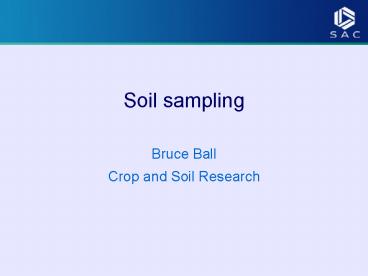Soil sampling - PowerPoint PPT Presentation
1 / 9
Title:
Soil sampling
Description:
Subdivide the soil across the landscape into classes that are fairly uniform ... A trowel of spade can be used, but this causes a lot of soil disturbance and can ... – PowerPoint PPT presentation
Number of Views:33
Avg rating:3.0/5.0
Title: Soil sampling
1
Soil sampling
- Bruce Ball
- Crop and Soil Research
2
Sampling location
- Subdivide the soil across the landscape into
classes that are fairly uniform - often single
field - - take guidance from soil maps, changes in
vegetation and topography - Avoid areas near fences, gates, water troughs and
spillages - Sample each uniform area in a W pattern
3
Sampling location
4
Sample number
- Take 5 - 10 samples from each location and bulk
by mixing in a bucket and subsample, or bulk and
use the whole sample - If the uniform area is bigger than 1 ha, more
samples are required. - Normally about 1 kg of soil is plenty for routine
soil analysis - Systematic grid sampling is required if you want
to pick up a suspected concentration gradient
5
Sample depth
- For fertility assessment, this is the normal
ploughing or digging depth (0-25 cm) (remove
surface vegetation before sampling) - For soil biological factors, sample near the
surface - Assessment of compaction and water movement may
require sampling below 25 cm depth
6
Sampling tools
- A trowel of spade can be used, but this causes a
lot of soil disturbance and can be difficult to
get depths correct. - Dutch auger - useful for loose, dry and stony
soils - Screw or spiral auger - easy to use, but can lose
dry soil and be held up by stones - C-section auger - good for discriminating depths
7
Auger types - from Eijkelkamp catalogue
8
Other sampling protocols
- Keep augers clean
- Collect soils in poly bags
- Label these before going to the field
- Routine fertility samples need not be dried or
kept cool - Samples for mineral nitrogen need to be kept cool
and sent for analysis within 24 h or frozen
9
General point
- Soils are highly variable - it is better to
sample a few properties at many locations than
many properties at few locations.































